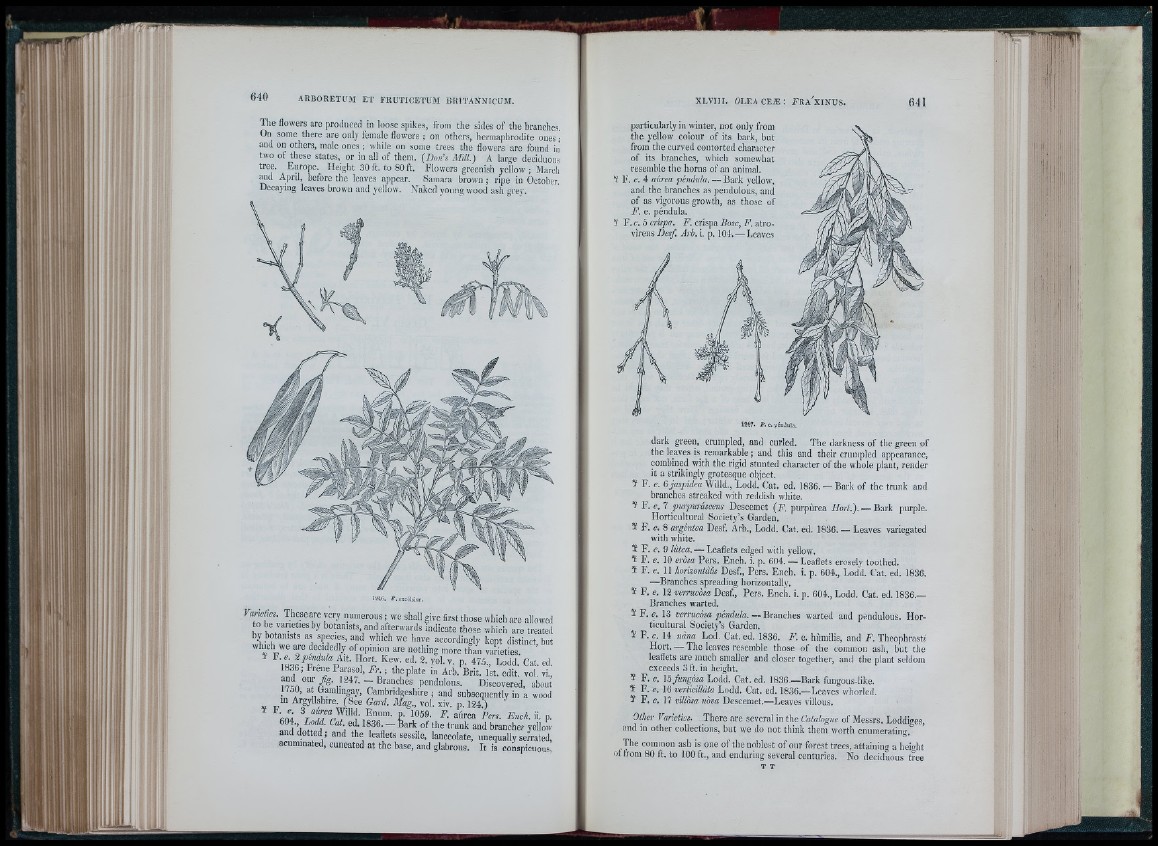
ì i
' ' .f I
:| I
L lL,.
The flowers are produced in loose spikes, from the sides of the branches.
On some there are only female flowers ; on others, hernmphrodite ones !
and on others, male ones ; while on some trees the flowers are found in
two of these states, or in all of them. {Boris Mill.) A large deciduous
tree. Europe.^ Height 30 Ft. to 80 ft. Flowers greenish yellow ; Marcli
and April, before the leaves appear. Samara brown ; ripe in October.
Decaying leaves brown and yellow. Naked yoimg wood ash grev.
12« i. i-.ex c cftic r,
Vanehes. T h /e a r e very numerous ,• we shall give first those which are allowed
bv hm^nists boffinists, and afterwards indicate tho.se which are treated
? I P?“ ? ’ whmh we aie decidedly of opinion are nothing“ m“ o'r-de inthgalyn kvearpite tideiss.tinct, but
1836; Fiene P /a s o l, Fr ; the plate in Arb. Brit. 1st. edit. vol. vi.,
I <?■ r ■ Z PenJuIous. Discovered, about
iinJ A Cambridgeshire ; and subsequently in a wood Argyllshire. (See Gard. Mag., vol. xiv. p. 124 )
3 Willd. Enum. p. 1059. F. aurea Pers. Ench. ii. p.
f f 1 branches yellow
and dotted ; and the leaflets sessile, lanceolate, unequally serrated,
acuminated, cuneated at the base, and glabrous. It is conspicuous.
particularly in winter, not only from
the 3'ellow colour of its bark, but
from the curved contorted character
of its branches, which somewhat
resemble the horns of an animal.
7 F. e. 4 aici'ea pendida. — Bark yellow,
and the branches as pendulous, and
of as vigorous growth, as those of
F. e. péndula.
5‘ Y .e .b crispía. crispa .ffoíc, F. atro-
vjrensDi?/ Arb.\. p. 104. — Leaves
\m. F.e.yénama.
dark green, crumpled, and curled. The darkness of the green of
tbe leaves is remarkable; and this and their crumpled appearance,
combined with the rigid stunted character of the whole plant, render
it a strikingly grotesque object.
¥ F. e. ^jaspidcaVi\M., Lodd.'Cat. ed. 1836.— Bark of the trunk and
branches streaked with reddish white.
¥ F. e. 7 purpurascens Descemet {F. purpùrea iZo?-/.). — Bark purple.
Horticultural Society’s Garden.
¥ F. e*. 8 argèntea Desf. Arb., Lodd. Cat. ed. 1836. — Leaves variegated
with white.
¥ F. e. 9 lùtea. — Leaflets edged with yellow.
¥ F. e. 10 erosa Pers. Ench. i. p. 604. — Leaflets erosely toothed.
¥ F. e. 11 horizontàlis Desf., Pers. Ench. i, p. 604., Lodd. Cat. ed. 1836.
—Branches spreading horizontally.
¥ F. e. 12 verrucosa Desf., Pers. Ench. i. p. 604., Lodd. Cat. ed. 1836.—
Branches warted.
¥ F. Ç. 13 verrucòsa péndida.— Branches warted and pendulous. Horticultural
Society’s Garden.
¥ F. e. 14 nana Lod- Cat. ed. 1836. F. e. hùmilis, and F. Theophrasti
Hort. — The leaves resemble those of the common asli, but the
leaflets are much smaller and closer together, and the plant seldom
exceeds 3 ft. in height.
¥ F. c. I5>wgÒ£a Lodd. Cat. ed. 1836.—Bark fungous-like.
¥ F. e. 16 verthillata Lodd. Cat. ed. 1836.—Leaves whorled.
¥ F. «?. 17 villosa nòva Descemet.—Leaves villous.
Other Varieties. There are several in the Catalogue of Messrs. Loddiges,
and in other collections, but we do not think them worth enumerating.
The common ash is one of the noblest of our forest trees, attaining a height
of from 80 ft. to 100 ft., and enduring several centuries. No deciduous tree
T T